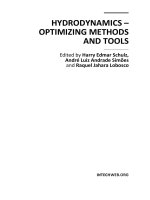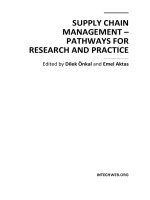Preservation of fruit and vegetables - Part 1 pot
Bạn đang xem bản rút gọn của tài liệu. Xem và tải ngay bản đầy đủ của tài liệu tại đây (198.12 KB, 14 trang )
Agrodok 3
Preservation of fruit and
vegetables
Ife Fitz James
Bas Kuipers
This publication is sponsored by: KERKINACTIE.
KERKINACTIE attaches high priority to rural development in its work, and supports
organisations active in this field. Agriculture and food production are activities of vital
importance in rural areas. Kerkinactie supports this kind of work directly and also indirectly
providing support for the collection, compilation and spread of information and knowledge.
© Agromisa Foundation, Wageningen, 2003.
A
ll rights reserved. No part of this book may be reproduced in any form, by print, photocopy,
microfilm or any other means, without written permission from the publisher.
First edition: 1984
Second revised edition: 1990
Third revised edition: 1997
Fourth, completely revised edition: 2003
A
uthors: Ife Fitz James, Bas Kuipers
Editor: Bas Kuipers
Illustrator: Mamadi Jabbi
Translation: Catharina de Kat-Reynen
ISBN: 90 77073 302
NUGI: 835
Foreword 3
Foreword
This Agrodok is meant to be a practical manual giving a review of the
simple techniques used to preserve fruits and vegetables.
In addition to information provided in the previous edition of this
Agrodok, this fourth edition covers more theoretical information on
food decay in general, its causes and dangerous effects, as well as
preventive measures that can be taken. In our opinion this knowledge
is necessary if you want to start a small-scale preserving business, to
which a whole chapter is devoted in this edition.
The general introduction deals with the principles of spoilage preven-
tion. The various methods of preserving are then explained, and the
main points of spoilage specific to the method are covered. The next
chapters deal with jam and juice making and attention is paid to dry-
ing vegetables and fruit, as well as salting of vegetables. Freezing is
not discussed, since this technique needs facilities usually not avail-
able in many developing countries. We have tried to describe every
method as practically as possible, including descriptions of the re-
quired materials and techniques.
Finally we would like to thank some people for their contributions to
the realization of this Agrodok: Domien Bruinsma for writing chapter
8 and critically reading the different concepts, Jan Schreurs for text
editing, Mamadi Jabbi for making some new illustrations and Willem
Würdemann for critically reading the content of this Agrodok.
Ife Fitz James
Bas Kuipers
Preservation of fruit and vegetables 4
Contents
1 Introduction 6
2 Food spoilage: causes, effects and prevention 8
2.1 What is food spoilage? 8
2.2 What are micro-organisms, and what factors affect their
growth? 10
2.3 What do micro-organisms do to fruits and vegetables? 12
3 Preparation 15
3.1 Cleaning and washing 15
3.2 Lye dip 15
3.3 Sorting 16
3.4 Peeling 16
3.5 Cutting 16
3.6 Blanching 17
4 Preserving by heating 19
4.1 Introduction 19
4.2 Packing 20
4.3 Preparation 23
4.4 Three types of heating 24
4.5 Storage and consumption 29
5 Drying 31
5.1 Quality of the fresh product 32
5.2 Preparation 32
5.3 Drying methods 34
5.4 When is the drying process finished? 40
5.5 Packing and storage 40
5.6 Consuming dried products 41
5.7 Three examples 42
6 Preserving vegetables with salt and/or vinegar 44
Contents 5
6.1 Preserving with salt 44
6.2 Requirements for salting 48
6.3 Preserving in vinegar 49
7 Jam and juice making, syrups, jellies and candied fruit
51
7.1 Making fruit juices 52
7.2 Preparation of other fruit products 58
8 Developing a small-scale food processing enterprise
61
8.1 Marketing a fresh or processed product 62
8.2 Organizing a processing enterprise 64
Further reading 68
Useful addresses 70
Appendix 1: Pasteurization of fruits and vegetables 72
Appendix 2: Sterilization in a boiling water bath 74
Appendix 3: Sterilization in a pressure cooker or autoclave
76
Appendix 4: Preparation and drying conditions 79
Appendix 5: Preparation of vegetables for salting 83
Appendix 6: Juice extraction methods 84
Glossary 86
Preservation of fruit and vegetables 6
1 Introduction
All living creatures, including humans, depend on nature for their
food. Humans are not only hunters and gatherers, but also farmers. We
live from hunting and fishing, agriculture and animal husbandry. Most
of our food consists of agricultural products, which are usually sea-
sonal and spoil quickly. To make food available throughout the year,
humans have developed methods to prolong the storage life of prod-
ucts: to preserve them. The rotting process can be postponed by add-
ing preservatives, optimizing storage conditions, or applying modern
techniques. The last option will not be discussed in this Agrodok. This
booklet focuses on the traditional preservation methods still com-
monly used in developing countries for fruits and vegetables.
Fruits and vegetables provide an abundant and inexpensive source of
energy, body-building nutrients, vitamins and minerals. Their nutri-
tional value is highest when they are fresh, but it is not always pos-
sible to consume them immediately. During the harvest season, fresh
produce is available in abundance, but at other times it is scarce.
Moreover, most fruits and vegetables are only edible for a very short
time, unless they are promptly and properly preserved.
This Agrodok will focus on a few simple and relatively inexpensive
preservation techniques that can be applied on a small scale by an
individual or a small group (of families for example). Chapter 2 pro-
vides information on food spoilage in general, its causes and danger-
ous effects, as well as measures that can be taken to prevent it. Spe-
cific knowledge is needed to apply the right preservation methods.
Fruits and vegetables have to be specially prepared, for example, be-
fore they can be preserved. How this is done is explained in Chapter 3.
Chapters 4 to 7 describe the various preservation methods: heating,
drying, and the use of additives such as salt and sugar. In times of
scarcity, preserved food can be sold for a good price. It can even be
worthwhile to start a small preserving business. Chapter 8 explains
what this would involve. More information can be found through the
Introduction 7
addresses and literature listed in Chapter 9 and in the appendixes that
follow, which provide specific information on how to prepare and
preserve the various types of fruits and vegetables. Various terms that
may be new to readers are defined in the glossary at the end of the
booklet.
Agromisa welcomes all readers’ comments that could contribute to
improving the quality of our publications. A survey form is therefore
included in the middle of this booklet, which can be completed and
returned to us. Readers seeking more information on food preservation
are also encouraged to contact Agromisa’s Question and Answer Ser-
vice at the address listed in the back of this booklet.
Preservation of fruit and vegetables 8
2 Food spoilage: causes, effects
and prevention
2.1 What is food spoilage?
Every change in food that causes it to lose its desired quality and
eventually become inedible is called food spoilage or rotting. As noted
earlier, this Agrodok focuses specifically on fruits and vegetables. As
long as they are not harvested, their quality remains relatively stable –
if they are not damaged by disease or eaten by insects or other ani-
mals. However, the harvest cannot be postponed indefinitely: when
the time is right, it is time to act. As soon as the fruits and vegetables
are cut off from their natural nutrient supply, their quality begins to
diminish. This is due to a natural process that starts as soon as the
biological cycle is broken by harvesting. Once it is harvested, the agri-
cultural product is edible for only a limited time, which can vary from
a few days to weeks. The product then begins to spoil or ‘rot’. We
distinguish between various types of spoilage:
1 physical spoilage
2 physiological aging
3 spoilage due to insects or rodents
4 mechanical damage
5 chemical and enzyme spoilage
6 microbial spoilage
Physical spoilage is caused for example by dehydration. Physiological
aging occurs as soon as the biological cycle is broken through harvest-
ing. Neither process can be prevented, but they can be delayed by stor-
ing the agricultural products in a dry and draft-free area at as low a
temperature as possible.
Insects and rodents can cause a lot of damage. Not only by eating the
products, but also by passing on micro-organisms through their hair
Food spoilage: causes, effects and prevention 9
and droppings. The affected parts of the plants are then especially
susceptible to diseases.
Chemical and enzyme spoilage occurs especially when vegetables and
fruit are damaged by falling or breaking. Such damage can release
enzymes that trigger chemical reactions. Tomatoes become soft, for
example, and apples and other types of fruit turn brown. The fruit can
also become rancid. The same processes can also be triggered by in-
sects: the fruit becomes damaged, which causes enzymes to be re-
leased. Enzymes can be deactivated by heating the fruit or vegetables.
The same effect can be achieved by making the fruit or vegetables
sour or by drying them, but the enzymes become active again as soon
as the acidity is reduced or water is added.
The peel of a fruit or vegetable provides natural protection against
micro-organisms. As soon as this shield is damaged by falling, crush-
ing, cutting, peeling or cooking, the chance of spoilage increases con-
siderably. Crushing occurs most often when fruits or vegetables are
piled up too high.
To prevent harvested products from spoiling, they can be preserved:
physiological aging and enzyme changes are then stopped and micro-
organisms are prevented from multiplying on the product. To retain
the desired quality of a product longer than if it were simply stored
after harvesting, it must be preserved. To preserve food it must first be
treated, with the goal of stopping physiological aging and enzyme
changes and preventing the growth of micro-organisms.
Before discussing the specific treatment methods, we will first focus
on the subject of micro-organisms. What are micro-organisms? Why
are they dangerous? How can you prevent them from making you
sick? The answers to these questions will help you understand the
steps required to safely preserve food.
Preservation of fruit and vegetables 10
2.2 What are micro-organisms, and what
factors affect their growth?
Micro-organisms are very small, one-celled animals. There are three
types: bacteria, moulds and yeasts. Bacteria and yeasts cannot be seen
with the naked eye, but moulds are often visible because they form
visible thin threads (filaments) or a solid cluster. Just like humans,
micro-organisms require certain minimum living conditions. They
cannot survive without:
? sufficient water
? oxygen
? the right degree of acidity
? nutrients
? the right temperature
Water is necessary for maintaining many physical processes. Where
there is a shortage or lack of water micro-organisms cannot grow, such
as in dried legumes. Drying is therefore one way to prevent spoilage.
Meat and fish do not have to be 100% dry in order to preserve them.
By adding salt, the remaining water becomes unsuitable for micro-
organisms. The same effect can be achieved by adding sugar to fruit.
Enzymatic spoilage is also inhibited by drying.
Most micro-organisms need oxygen. If there is a shortage of oxygen,
it is difficult for bacteria to survive, let alone multiply. But there are
always a few that manage to survive. As soon as the oxygen supply is
increased, these remaining bacteria will again grow and multiply.
Some types of micro-organisms even thrive in an oxygen-poor envi-
ronment.
Bacteria grow best in an environment that is not too acidic. Less
acidic products are therefore especially susceptible to bacterial spoil-
age. Examples of such products are meat, eggs, milk and various types
of vegetables. Beer, yoghurt, wine, vinegar and fruit are less sensitive
because they are more acidic. Adding acidity to products slows down
the process of microbial spoilage. The degree of acidity is measured as
a pH level. A neutral product like milk has a pH of 7; meat has a pH of
Food spoilage: causes, effects and prevention 11
about 6, carrots have a pH of 5 and oranges about 4. The more acidic a
product is, the lower the pH value will be.
Just like humans, micro-organisms also need nutrients: sugars, pro-
teins, fats, minerals and vitamins. These are rarely in short supply,
because they can be found in all food products.
To thrive, micro-organisms need a temperature of between 5 and
65°C. At temperatures above 65°C it becomes very difficult for them
to survive; and they definitely die if boiled, as long as they are boiled
for a certain length of time, such as 10 minutes. When heated, the
micro-organisms slowly die off, but not all at the same time. Heating
at temperatures lower than 100°C thus has to be sustained for a longer
period. The growth of micro-organisms is also slowed down signifi-
cantly at temperatures between 0 and 5°C (as in a refrigerator), which
makes it possible to store the food products for a few additional days.
At temperatures below 0°C microbial growth is stopped completely,
but the micro-organisms themselves remain alive. They will become
active again as soon as the temperature rises above 0°C.
To preserve food, it is sometimes necessary to make drastic changes to
the micro-organisms’ living conditions. We can remove water (dry-
ing), increase the acidity, or first heat the products (to kill the bacteria)
and then store them in air-tight containers to prevent oxygen from
entering (preserving/canning). These and other methods will be dis-
cussed later in this booklet.
Do micro-organisms grow differently on vegetables and fruit?
Vegetables and fruit have a lot in common. But there are also impor-
tant differences, which determine the type of spoilage they are most
susceptible to. Damaged fruits, which are usually somewhat acidic,
are very susceptible to the growth of yeasts and moulds. Vegetables
are generally less acidic, and their spoilage is usually caused by bac-
teria. Though not visible to the naked eye, bacteria can still be present
in large numbers.
Preservation of fruit and vegetables 12
What types of micro-organisms grow on what products?
? Moulds can be found on almost all food products. They are often
very visible and can significantly alter the taste of the products.
They grow the best in low temperatures in an acidic environment
and on dry products such as grains and bread. Some moulds pro-
duce poisonous substances, especially in moist seeds such as pea-
nuts, corn and soy beans.
? Yeasts can also cause food to spoil. They prefer low temperatures
and acidic products.
? Bacteria can grow on almost all types of fresh food that is not too
acidic: meat, fish, milk and vegetables. One type of bacteria carries
a kind of seed, called a spore. Spores can survive at a temperature
of 100°C, even though the bacteria themselves die. Once the tem-
perature drops, new bacteria can grow out of the spores. To kill the
spores, they must be exposed to a temperature of 121°C. This is
called sterilization.
2.3 What do micro-organisms do to fruits and
vegetables?
Micro-organisms take from food products the various substances they
need to survive and multiply. Their secreted waste products can have
either a negative or positive effect on the affected food and the hu-
mans who eat it.
Positive effects of micro-organisms in food
The waste products secreted by some micro-organisms can have a
positive effect on food. Lactic acid bacteria, for example, are used to
make cheese and yoghurt from milk, and sauerkraut from white cab-
bage. Moulds are used to make tempeh from soy beans, and yeasts are
used to make beer and bread. These substances influence the taste and
structure of the food products and generally increase their shelf-life.
The products can be kept longer because the desired micro-organisms
decrease the food’s pH level or because they are present in such huge
numbers that other micro-organisms have no chance to grow. This use
Food spoilage: causes, effects and prevention 13
of micro-organisms for the preparation of food is called fermentation.
More information on this process is given in Chapter 6.
Negative effects of micro-organisms in food
Sometimes the negative effects of bacteria are clearly apparent, such
as when milk has turned sour and curdled, when meat is covered in
slime, when moulds and gasses have formed, and when food has a
distinctly putrid smell. However, food spoilage is not always this ob-
vious. There are bacteria whose presence in food does not always
cause a change in its taste or appearance. In any case, it is important to
avoid eating rotten food, because it can make a person seriously ill.
Eating rotten food can cause contamination or poisoning. A food con-
tamination occurs when a person consumes a large number of living
micro-organisms in a meal. These can multiply rapidly in the person’s
gastrointestinal tract and severely disturb the digestive system. The
result is often diarrhoea and sometimes also bleeding. The symptoms
appear between 3 and 24 hours after eating the rotten food. A food
contamination can be prevented by frying or boiling the food thor-
oughly, since sufficient heating will kill the micro-organisms.
Food poisoning occurs when a person consumes food containing the
poisonous waste products secreted by the bacteria. Heating the food
does not help in this case: the bacteria will be killed, but the poisonous
waste will remain unharmed. Both food poisoning and food contami-
nations can be lethal, but usually they only make a person sick.
How do micro-organisms come in contact with fruits and
vegetables?
Spoilage caused by yeasts, moulds and bacteria develops slowly and is
not always noticeable. The most important sources of microbial con-
taminations are sand, water, air, and pests such as insects and rodents.
Food products can also be infected by people. Micro-organisms are
everywhere around us. To prevent them from reaching our food in
great numbers, it is important to work as hygienically as possible
when handling fruits and vegetables, for example.
Preservation of fruit and vegetables 14
The following practices are therefore recommended:
? Wash your hands thoroughly with hot water and soap before begin-
ning to prepare food.
? Make sure that kitchen utensils and appliances are well cleaned and
disinfected.
? Always store food in a clean place.
? Use herbs and spices as little as possible, because they are an im-
portant source of contamination.
? Use clean and pure salt only – if the salt is not pure, heat it on a dry,
metal sheet above the fire.
? Allow only clean drinking water to come in contact with fruits and
vegetables.
? Never allow anyone who is sick or has open wounds to come in
contact with food that is to be preserved.









